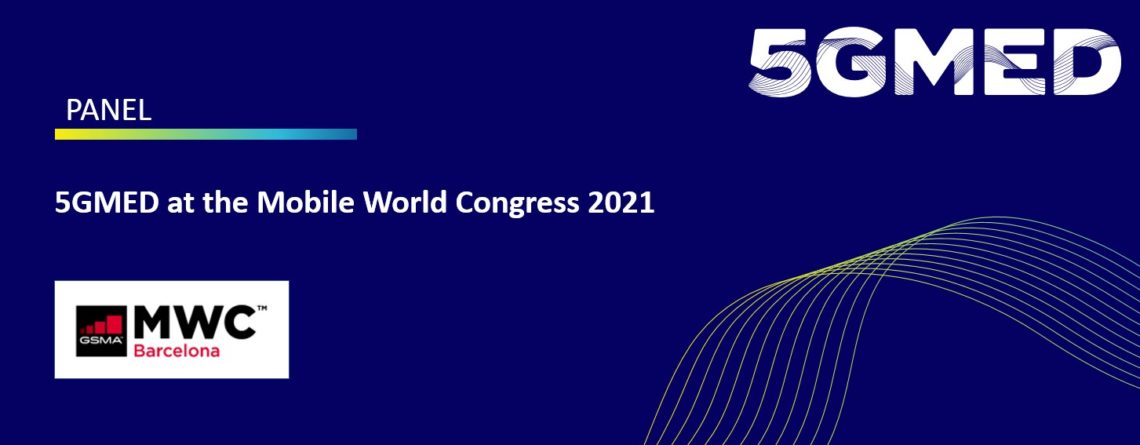5GMED at the Mobile World Congress 2021
After one year without one of the most important Telecom events in Europe, the Mobile World Congress has come back for a special edition, mixing keynotes with in-person and online people. For the first day of the Congress, the 5GMED project has been the focus conversation of a hybrid panel.
The future of mobility in the Mediterranean cross-border corridor had also its place during the Mobile World Congress. On the past 28th of June, for the first day of the Congress, project coordinator, Raül Gonzalez Prats from Cellnex has gathered for a debate focused on the 5G technologies and the future CCAM and FRMCS services two of the partners of 5GMED, Xavier Daura (Albertis) and Oyunchimeg Shagdar (Vedecom) as well as the 5G Barcelona manager, Tomeu Sabater from Mobile World Capital and the Project Officer from the European Commission, Christian Micas. The panel conversation was moderated by Monique Calisti from Martel.
5GMED ambition is to be the reference for the rest of the corridors in the future

The introduction of the panel was held by the project coordinator who introduced 5GMED as the future reference for the rest of the corridors in the future: “It is not only a technological project but also a project that wants to be a reality in the rest of the more than 20000 km of corridors in Europe.”, says Gonzalez Prats. “There is a necessity to work not only in the infrastructure and the technology but also in the business model, and to work with all the stakeholders that will use the infrastructure in the future”.
“5GMED will provide very useful insights preparing for the large-scale deployment.”

Monique Calisti, from Martel, moderated the panel discussion starting with asking Christian Micas his opinion on the Trans-European Transport Network (TEN-T). The senior project officer has emphasized that 5GMED will have an especially key role within the other 6 Horizon 2020 cross-border trial projects, currently testing and validating 5g enabled connected and automated mobility use cases and solutions. Micas has assured that 5GMED will provide extremely useful insights that will help to prepare for the large-scale deployment.
“5gmed will developed the first micromanagement strategy”
According to Xavier Daura from Albertis, the infrastructure developed by 5GMED project will have a key role in the future environment of mixed traffic mobility that will last for a long period: “It will mean digitalise the infrastructure to support this new connect vehicles and create a new proactive management centre to guarantee the smooth and safety mobility”. Daura added that 5G is the key to accelerate this new mobility that has many advantages and opportunities in terms of technology and costs. In 5GMED project, explained Daura, there are three levels of digitalisation: digital and physical infrastructure, MEC new management and the management in the cloud. Furthermore, 5GMED will develop a smart sensor with a single camera installed in the site of the infrastructure to ensure data transmission in real-time.
“To find the maximum synergy between the road and the railway infrastructure.”

Regarding the objectives of 5GMED, it is clear for Raul Gonzalez that the project has to allow any kind of services to run independently of the 5G structure used. Another important goal of the project is to find the maximum synergy between the road and the railway infrastructure as the main target is to design a common road and railway 5g infrastructure architecture. The R&D team leader from Vedecom, Oyunchimeg Shagdar, explained how 5GMED will ensure 100% of connectivity in the road with the aggregation architecture and in the railway through the satellite communication: “There have to be a 100% of connectivity but not necessary in a high quality, what is a need, is to ensure the services continuity.”
The 5G technologies helping reducing energy consumption.

Since December 2019, the European Commission has adopted the European Green deal. According to Micas, transport must become smarter to improve road safety, optimise road traffic, and reduce greenhouse emissions and traffic congestion. Concerning the sustainability perspectives, the senior officer, 5G can help with the reduction of energy consumption. From the 5GMED perspective, the project will try to use the benefit of wireless communication and the auto-generation of energy.
5GMed will demonstrate advanced Cooperative Connected and Automated Mobility (CCAM) and Future Railway Mobile Communications System services (FRMCS) along the “Figueres Perpignan” cross border corridor between Spain and France Enabled by a multi-stakeholder compute and network infrastructure deployed by MNOs, neutral hosts, and road and rail operators, based on 5G and offering support for AI functions.
More info
5gmed.eu
Follows us on social media
Linkedin
Twitter


